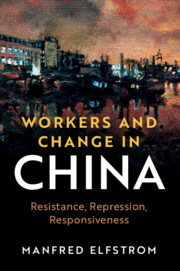Book contents
- Workers and Change in China
- Cambridge Studies in Contentious Politics
- Workers and Change in China
- Copyright page
- Dedication
- Contents
- Figures
- Maps
- Tables
- Acknowledgments
- 1 Introduction
- 2 Recipes for Resistance
- 3 Bureaucratic Incentives
- 4 Orthodox Control
- 5 Risk-Taking Control
- 6 Increased Repressive and Responsive Capacity
- 7 Bottom-Up versus Top-Down Change
- 8 Conclusion
- Appendices
- References
- Index
- Series page
6 - Increased Repressive and Responsive Capacity
Published online by Cambridge University Press: 14 January 2021
- Workers and Change in China
- Cambridge Studies in Contentious Politics
- Workers and Change in China
- Copyright page
- Dedication
- Contents
- Figures
- Maps
- Tables
- Acknowledgments
- 1 Introduction
- 2 Recipes for Resistance
- 3 Bureaucratic Incentives
- 4 Orthodox Control
- 5 Risk-Taking Control
- 6 Increased Repressive and Responsive Capacity
- 7 Bottom-Up versus Top-Down Change
- 8 Conclusion
- Appendices
- References
- Index
- Series page
Summary
The Yangtze River Delta and Pearl River Delta dynamics that were described in the previous chapters show the different models of control that have developed in different parts of the country facing different forms of worker resistance but the same bureaucratic incentives to maintain stability. However, focusing only on such models risks missing the forest for the trees. Beneath the country’s various local approaches to managing industrial relations, we can also identify broad, average trends. Specifically, where unrest is more intense, the government is enhancing both its repressive and responsive capacity. Capacity does not map neatly onto the specific tactics discussed in previous chapters. For instance, is preemption more responsive or repressive? Does it require more capacity than reaction? Does not nudging mix both repressive and responsive elements? But as local governments clash repeatedly with labor and develop their distinct models of control, they accumulate repressive and responsive resources – everything from riot shields to informants, to arbitrators, to skilled trade union leaders – and a greater facility for using them. Gradually, the Chinese state as a whole is strengthened in a dual manner. In this chapter, I first describe the variety of forms that repressive and responsive capacity can take in the Chinese context, some of which have appeared in previous chapters and some of which have not. Using spending on the paramilitary People’s Armed Police and formally adjudicated employment dispute data, I then show how capacity has risen in tandem with strikes, protests, and riots, all else being equal. Finally, I draw on interviews to address a lingering issue that I cannot control for in my statistical analysis, namely the overlap between labor and land use conflicts in some areas. The stage is then set for my penultimate chapter concerning the role of elites in Chinese labor politics and final chapter reflecting on what all this means for China: Is this all just further evidence of the state’s adaptability? Is becoming empowered along these two clashing dimensions sustainable?
- Type
- Chapter
- Information
- Workers and Change in ChinaResistance, Repression, Responsiveness, pp. 110 - 128Publisher: Cambridge University PressPrint publication year: 2021

